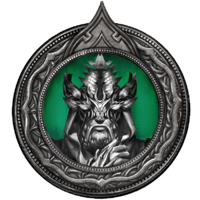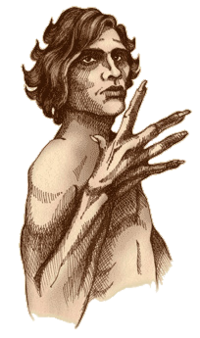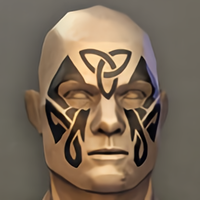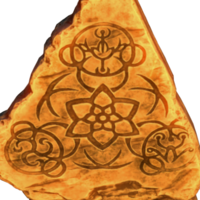Lore:Druids of Galen
|
This article is about the first druidic circle which is now-defunct. For practitioners of the Druidism in general, see Druids. |
The Druids of Galen[1][2][3][4] (also known as the descendants of Galen,[5] the druids of old,[6] and the druids of the circle)[7] is a moniker used to describe an ancient and obscure group of people that underwent two major shifts in both cultural and racial makeup. They followed Y'ffre's True Way (later known as Druidism)[5][8][9] in which the eponymous god took the forefront of their faith. Under it, one is to lead a life connecting with and valuing the natural world[10] referred to as the Green.[7] Some reverence was also shown to the stars, especially the Ritual constellation.[5] They held onto the Oak's Promise, a belief to "stand strong, stay true, and shelter all".[11]
The racial makeup of the Druids of Galen depends on the time period. The moniker is typically used as a retroactive nomenclature to refer to the ancient people that survived in ancient High Rock by tapping into and nurturing nature.[7][4][6][5] Referred to as proto-Bretons,[7][UOL 1] they were the Nedic ancestors of the Bretons[4][12][1][13] that intermingled with the Aldmer[14] (primarily the Direnni) for centuries during the Merethic Era.[4][12] In the context of the Nedic Druids of Galen, the moniker is a largely academic term, and what is known about them is mostly legend.[3] By the Fourth Century of the First Era, the ethnicity of the group was already "Breton-y".[12]
The first cultural shift started shortly after the Bretons (then called "Manmer" and "Half-Elves")[15][16] were conceived as unwanted half-breeds,[8] rejected by their Direnni parents that considered them sub-Mer.[8][5] The druids of old led this newly emerged race,[UOL 2] and Manmer were elevated in Nedic society, where they thrived.[4][15] Druids as a distinct identity was not introduced until around this time period.[5][8] This was further warranted when the Wyrd diverged from the True Way in a religious schism, ultimately driven away by the "excesses of the Elves".[5] The Wyrd abandoned civilization in favor of living in the wilds,[5] and believe that they are nature itself, such as the forest, its beasts and flora, and even the weather.[5][17] Druids in contrast accepted their "proper place" as people, and embraced civilization coexisting alongside nature.[5][6][18][19] The Druids of Galen found unsavory the Wyrd's ways, while the Wyrd in turn saw ancient druids as "barons in ivy robes" that were as bad as city-dwellers.[19]
Their second cultural shift was prompted in response to their exile to the Systres,[18][12] which came with a change in their attitudes towards historical encroachments and the deprivations of their homeland.[5][6] Historically, ancient druids were considered "Meriphilic",[20] but eventually their tolerance for outside influence would wane and they would find themselves fighting for the soul of High Rock.[18] The Druids of Galen wanted self-governance without the Direnni's interference, as well as freedom from the religious persecution such as that from the Alessian Order,[5][6] but ultimately they lost.[18][12] The Druids of Galen were a united entity[19] led by a line of ancient kings,[6] and they were already Bretons themselves by the time the last Druid King led them on their exodus to find a new home.[12] When they arrived on the Systres, they disbanded and then reorganized themselves into druidic circles that vary in belief.[18][5][UOL 3] Ironically, modern druids share similarities to the Wyrd in that they in that they practice self-isolation to varying degrees. Indeed, xenophobia among the druidic circles varies in the modern day, with the Stonelore being welcoming and taking willing converts, and the Eldertide and Firesong being hostile.[18][21]
History[edit]
The Proto-Bretons of High Rock[edit]
- "The story of the druids is the story of the Bretons. And of the wyrd. At least to a point. You ask what we as druids believe, and I say that what we believe comes from where we were born. And both the wyrd and the druids—indeed, all Bretons—rocked in the same cradle." — Wyrd and Druid
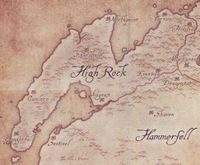
Druidic history is primarily oral history,[7] for many records have been lost, and druidkind has been nearly wiped out several times throughout history.[22][3] Naturally, the origin of the Druids of Galen is steeped in myth. Some say a Nedic figure known as Druid Queen Galen was one of the first to channel the songs of Y'ffre, and became the first Archdruid. Others believe the True Way emerged from an island named Galen in the middle of a lake, where Breton's forebears heard Y'ffre's heart beating; yet in another, Galen was the name of a spirit that wandered into a proto-Breton settlement and taught them of the Green.[7] Y'ffre's name itself was not known until the "daughters and sons … [of] Anuiel" taught it to Breton's forebears.[5] Regardless of the origin, it is agreed that the True Way was born in High Rock.[23]
If Man or Mer came to High Rock first is debated in scholarly circles. Some believe that Nedic civilization and their Druid King were already established in the province when the Aldmer arrived,[4] while others claim that the Nedes arrived in High Rock afterwards, and encountered the elves gradually with a variety of reactions and outcomes.[24][25][UOL 4] There is evidence of human settlements in High Rock dating back at least a thousand years before recorded history.[26] Archaeological excavations have dated the ruins of Nedic habitation to as early as ME 1000, predating Ysgramor by centuries.[24] The Nedes of Stormhaven had strained relations with the neighboring Orc clans, which regularly clashed with other Orc clans and their Nedic neighbors.[27] The Aldmer that settled High Rock did so sparsely and in very specific locations, the most successful being Clan Direnni,[25] who came to the province from the Summerset Isles in the Middle Merethic Era.[28][29] There's also evidence that a beastfolk population were High Rock's original inhabitants, though they did not build permanent communities, and what interactions they had with Men and Mer are unknown.[25]
The Direnni didn't enslave the Nedes as the Ayleids of Cyrodiil did; instead, they ruled them as a noble caste. The elves established a system of feudal vassalage over their new subjects and took Nedic concubines.[15][29] They inevitably interbred with their human subjects, producing Half-Elven children (also known as Manmer).[15][16]
Druids arise as a Distinct Identity[edit]
- "The Wyrds of High Rock distance themselves from politics, but the druids of old were a different breed. They used fearsome magic to rule over the early Bretons, either directly or from behind the scenes. And they jealously guarded their power."
— High King Emeric
The Druids of Galen led this new race when it first emerged,[UOL 2] as children begat from Elf-Nede relations were considered sub-Mer and not accepted by their Direnni parents. Instead, they were given privileged positions among the Nedes, which eventually led to a recognizable mixed-blood human caste dubbed "Bretons", from the Ehlnofex "beratu", meaning "half".[4][15] These Bretons were only allowed to marry humans, and over time, the Bretons' human features became more prominent than their elven traits.[15] Shortly after the Breton race emerged, Druidic spellcraft became the first truly Breton creation, and "druid" as a distinct identity was fully realized.[5][8] Though the term Manmer is archaic in the modern day, Breton druids embrace this heritage by still referring to themselves as such,[5][30] and believe in Breton's ability to enhance or perfect nature.[30] Indeed, the modern Breton has a natural affinity for environmental manipulation.[31]
Eventually, the witches of the Wyrd diverged from the True Way in a religious schism, ultimately driven away by what they called the "excesses of the Elves".[5] In druidic belief, mortals[5] were not meant to separate themselves from nature, as one can rejuvenate and enjoy Y'ffre's bounty through it.[32][18] While the druids revere nature, they were not keen to isolate themselves and worship the untamed wilds.[5][6] Therein lies the primary difference in culture between druids and the Wyrd: the Wyrd abandoned civilization in favor of living in the wilds,[5] and believe that they are nature itself: the forest, the plants and beasts within it, and even the weather.[33][5] In contrast, druids accepted what they interpreted as their "proper place" as people, and embraced the idea that civilization can coexist alongside nature.[5][6][18][19] The Druids of Galen and the Wyrd disapproved of each other's lifestyles: the druids found the ways of the Wyrd unsavory, and the Wyrd thought the druids were no better than city-dwellers.[19] Druids would much later practice self-isolation to varying degrees,[34][18][21] as a response to the historical encroachments and heartless deprivations that would await them.[5][6]
While the Aldmer maintained control of Tamriel, Clan Direnni coexisted peacefully alongside their Nedic and Half-Elven subjects.[24] The Direnni ruled largely through their Nedic clients,[UOL 4] while the Druids of Galen used their fearsome magic to enforce their influence over early Bretons, and the Wyrd avoided politics altogether.[35] Some Manmeri devotional idols from this period depict Mara as an elven woman in a lover's embrace with a man, suggesting Aldmeri culture may have been welcomed with relatively open arms.[36] However, their comity would not last: localized groups of Bretons displeased with Mer butted heads with their Elven overlords long before they officially came to blows.[12]
The Direnni seeking to tame nature, forged a pact with the Earthbones to protect their settlements from the encroachment of the wilds,[37] while the Druids of Galen believed civilization should live alongside nature and not tame it.[18] Ultimately, the Druids of Galen split from their Breton brethren around 1E 330, when two major powers vowed for control of High Rock. The Direnni Hegemony did not take kindly to the attempts for druidic governance of the province, and the Alessian Order persecuted them as they deviated from their religion.[5] Following the guidance of Y'ffre's visions[23] (or a song or an Elder Scroll),[20] Druid King Kasorayn led somewhere between an estimated few thousand to a million druids on an exodus to the Systres,[23][20] and a few remained on the mainland.[18] It is said that for their exodus, Kasorayn received a vision from Y'ffre which taught him how to sing the plants and trees of High Rock into seaworthy vessels, and he in turn taught the druids how to do so.[23]
The Druids of Galen's journey to the Systres was not without setbacks. A member of their group, Saer, started to dabble in necromancy. This curiosity turned sinister when the druids came across an island in the Abecean containing an abandoned Dwemer facility with a device used to control the weather. Saer sensed something within the ruin and implored some of his crewmates to explore it. What resulted was deep within, Saer ascended into Lichdom, and some of those that accompanied him became entombed with him, while others managed to escape and rejoin the flotilla.[38][39] The area around the facility became known as Graven Deep, and those that came near it would vanish.[38][40]
Dissolution[edit]
When the Druids of Galen arrived to the Systres, the Draoife terraformed a barren volcanic island into a lush and verdant volcanic paradise and named it Y'ffelon. The druids then swiftly expanded across the rest of the archipelago,[41] sprouting life where it was once barren.[20] The dissolution of the Druids of Galen was brought about with the event known as the "three mornings of sail", when priest-navigators set out to sea on enchanted vessels outside the archipelago. Their outside experiences and their interactions with different races resulted in three sects developing, each with their own interpretation of Y'ffre's will; the Stonelore, Eldertide, and Firesong Circles.[18][20]
Other sources claim Kasorayn caused the druidic schism when he foresaw a coming disaster in a prophecy now known as the Dream of Kasorayn.[22] Before the Druids of Galen ventured into the Systres, the last Druid King visited both the Beldama[38] and Glenmoril Wyrd Covens in preparation.[22] Together, they nurtured the nature spirit known as Frii from the dream of the Green.[42][43] Frii was the Sower, the entity that was to create sacred seeds which were to contain the regalia of the Druid King, royal symbols to be passed onto the future druidic circles.[42]
Despite the religious schism, to symbolize their unity matters more and that they share the same goals, the druidic circles came to shaping knot-work into a triquetra,[44] a symbol that would become adopted by civilized Bretons.[45] Kasorayn himself took on the role of an observer after he helped established the druids on the isle, and only intervened when necessary. The druidic monarchy ended after heretics from the Allwither Order who possibly wanted to enact revenge on their former Elven oppressors[3] attempted to seize the Ivy Throne.[46] The Allwither heretics were defeated,[46] but the Druid King's symbology disappeared almost overnight.[6][47] Filling the leadership role after Kasorayn's murder was the Draoife (meaning druidic council), which consists of some of the most influential members of each druidic circle. They handle the leadership role for modern druids, settling disputes and handling concerns.[22]
It is unknown what happened to the few Druids of Galen that remained on the mainland, but in Stonelore tales, these forsaken also split into circles and roamed Tamriel's forests doing Y'ffre's will.[18] By the Interregnum, druids had been absent in High Rock for centuries.[19]
Circa 2E 582, members of the Undaunted traveled to Graven Deep to put an end to the disappearances in the area and slew the lich Zelvraak the Unbreathing (formerly known as Saer), one of the last Druids of Galen.[48]
Future[edit]

While the druids of old are gone, Systrean druids still consider themselves to be the Druids of Galen at least in name in that the title is special and conveys "solace, home and hearth, reverence and conservation".[7] One possible future in the Dream of Kasorayn was the Green Renewal, which involves the druid circles merging and taking their place back in Tamriel, but this is after the willing election of a new Druid King.[22] The other future was the Green Scourge, where a tyrant would take the reins and nature would run amok among the tyranny of the druids.[22]
The Firesong Circle wish to reestablish the Druids of Galen by fulfilling the Dream of Kasorayn.[UOL 3][UOL 5] Circa 2E 582, they assassinated the Draoife when they refused to elect a new Druid King, and made moves to obtain the other circle's seeds. The leader of the Firesong was disposed of, but the puppeteer and leader of the Ascendant Order, Lord Bacaro Volorus, took matters to his own hands and took the Ivy Throne. Bacaro's reign was swiftly put to an end by the Vestige, and thus the Green Scourge was prevented.[50]
Count Stefan Mornard subsequently sought to give the druid circles a voice in the governing of the Systres island of Galen, believing this would give way to a new path to combine both legacies into something new. He however felt druids don't require a king or a prophecy to make the world a better place, and that for too long had House Mornard and druids have sought to reclaim the glory of the past.[34] Indeed, the Druids of Galen may not be resurrected, for Kasorayn's dream may simply be a metaphor. Druid Laurel of the Stonelore Circle believes that druidkind should live life like it is close at hand, however.[22]
How the Systres becoming part of Hammerfell's territory by 3E 427[51] affected the archipelago's druid inhabitants is unknown, but by the Fifth Century of the Third Era, druids were once again present in the regions of the Iliac Bay.[49][UOL 6] It is also unknown if modern druids were still fragmented into circles or once again operated under single banner of the Druids of Galen. "By the ArchDruid" is a common exclamation by Bretons of this era.[52][53]
Alternative Fate[edit]
The Psijic Order had the means to scry secrets from fate lines beyond the bounds of Tamriel. Among these secrets were tomes that spoke of alternative timelines and realities, where certain key events transpired differently.[54] In one of these alternate realities, Lord Bacaro Volorus defeated his other enemies circa 2E 582 and ruled over Tamriel from atop his Ivy Throne in Mount Firesong in a new druidic reign. With his victory, Tamriel was engulfed in firestorms targeting "false kings and queens", and those displaced by them were assisted by the reformed Druids of Galen, as well as the Ascendant Order and the Society of the Steadfast. Dark and cold days filled with turmoil were the norm during this transition, as volcanoes continued to "belch forth their retribution" covering the skies, but according to Bacaro's subordinates, the hardships would pass and the Ascendant Lord would uplift Tamriel's citizens.[55]
Notes[edit]
- The Druids of Galen were first mentioned in The Elder Scrolls: Arena when creating a Breton, with the line:
- "Thy race is descended from the ancient Druids of Galen, quick witted and strong in the mystical arts. Thy folks are crafty and intelligent, a learned people who use their gifts to guide others to enlightenment..."
- When asked about the Druids of Galen during an interview, Arena designer Ted Peterson said he knew nothing about them.[UOL 7]
- The book Wyrd and Druid was corrected due to imprecise writing implying the Druids of Galen already existed as Manmer in ancient High Rock. The previous revision can be viewed here.
See Also[edit]
- For game-specific information, see the Elder Scrolls Online article.
References[edit]
- ^ a b Breton description in Arena
- ^ Events of ESO: Legacy of the Bretons
- ^ a b c d Systres History Addendum: The Druids of Galen — Varona Vedralu, Senior Lecturer, University of Gwylim
- ^ a b c d e f g Modern Day Bretons: Man or Mer? — Vastyr Historian Filibert Beauchamp
- ^ a b c d e f g h i j k l m n o p q r s t u v w x Wyrd and Druid — Archdruid Barnabe's Discourse with Mainlanders, 2E 553
- ^ a b c d e f g h i j Loremaster's Archive - Bretons & High Isle — Lady Arabelle
- ^ a b c d e f g Loremaster's Archive - The Druid Circles of Galen — Laurel of the Stonelore
- ^ a b c d e Legacy of the Bretons — Stefan Mornard
- ^ Meet the Character - Sir Stefan Mornard — Knight Commander Jourvel
- ^ Druid Audrine's dialogue in ESO
- ^ Oak's Promise Face Marks Body Marking description in ESO
- ^ a b c d e f g Loremaster's Archive - Tamriel's Dungeons — Dhulef
- ^ High Isle Preview—The Zone from the official ESO website
- ^ Pocket Guide to the Empire, 3rd Edition: All the Eras of Man, A Comprehensive History of our History — Imperial Geographical Society, 3E 432
- ^ a b c d e f The Bretons: Mongrels or Paragons? — Phrastus of Elinhir
- ^ a b Pocket Guide to the Empire, 1st Edition: High Rock — Imperial Geographical Society, 2E 864
- ^ Wyress Demara and Wyress Linnae's dialogue in ESO
- ^ a b c d e f g h i j k l m Druid Ryvana's dialogue in ESO
- ^ a b c d e f Wyress Matilde's dialogue in ESO
- ^ a b c d e Systres History: Volume 1 — Trilam Heladren, Associate Dean of Eltheric History, University of Gwylim
- ^ a b Druid Peeska's dialogue in ESO: High Isle
- ^ a b c d e f g Druid Laurel's dialogue in ESO
- ^ a b c d Exodus of the Druids — Druid Laurel of the Stonelore Circle
- ^ a b c Frontier, Conquest — University of Gwylim Press, 3E 344
- ^ a b c Pocket Guide to the Empire, 3rd Edition: The Sons and Daughter of the Direnni West: High Rock — Imperial Geographical Society, 3E 432
- ^ A History of Daggerfall — Odiva Gallwood
- ^ Nedic Hex Totem Antiquity codex entries in ESO: Greymoor
- ^ Before the Ages of Man — Aicantar of Shimerene
- ^ a b Once — Beredalmo the Signifier
- ^ a b Draoife Storystone codex entries in ESO: High Isle
- ^ Introduction to the Lore of The Elder Scrolls Online
- ^ Druid Farel's dialogue in ESO: High Isle
- ^ Wyress Demara and Wyress Linnae's dialogue in ESO
- ^ a b Sir Stefan Mornard's dialogue in ESO
- ^ High King Emeric's dialogue in ESO: Firesong
- ^ Manmer Coupled Idol codex entries in ESO: Greymoor
- ^ The Viridian Sentinel
- ^ a b c Logbook of Druid Anwas — Druid Anwas
- ^ Logbook of Druid Betrys — Druid Betrys
- ^ Dhulef's dialogue in ESO
- ^ Secrets of Amenos — Miramel Charascel, Chairperson of the Gonfalon Bay Historical and Social Society
- ^ a b Frii's dialogue in ESO
- ^ Sojourn of the Druid King quest in ESO
- ^ Druidic Knotwork Body Tattoos markings description in ESO
- ^ Crafting Motif 93: Ancestral Breton Style — Serge Serlyn, "Military Scholar of Much Renown"
- ^ a b Druid King Kasorayn's dialogue in ESO
- ^ Stonelore Circle Effigy in ESO
- ^ Haunted Depths quest in ESO
- ^ a b Death cutscene in Daggerfall
- ^ Events of Firesong DLC in ESO
- ^ Map of Tamriel – Morrowind Codex
- ^ Breton exclamations in Arena
- ^ Breton exclamations in Daggerfall
- ^ Tracker of Temporal Tomes achievement description in ESO
- ^ Coral Aerie Temporal Tome — Varallion
Note: The following references are considered to be unofficial sources. They are included to round off this article and may not be authoritative or conclusive.
- ^ Leamon Tuttle's Posts - 04/24/2022
- ^ a b How Druids tie into the Breton Legacy section in Firesong DLC & Update 36 Preview
- ^ a b https://www.twitch.tv/videos/1604662466 Twitch Stream of ESO Live Legacy of the Bretons Autumn Event, time stamp 59:10-59:26
- ^ a b Lawrence Schick and Phrastus on Altmer Culture
- ^ https://www.youtube.com/watch?v=JhQeU-Izx1w Youtube Stream of Firesong DLC Guided Tour with the Developers, time stamp 25:33-26:08
- ^ The Dragon's Eyrie/Daggerfall
- ^ Ted Peterson on High Rock and Summerset - Legendary Edition — The Imperial Library
| ||||||||||||||||||||||||||
